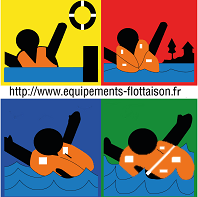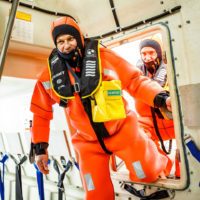Regulation 18 Suitability of personal protective equipment for use in an emergency
(1) In relation to personal protective equipment which protects a person in an emergency against risks to his health and safety – [google-translator]
(a) in conditions of fire, heat, smoke, fumes or toxic gas; or
(b) in the event of his immersion in the sea,
the duty holder shall, for the purposes of the Personal Protective Equipment at Work Regulations 1992, be treated as the only employer of all persons on the installation, and such persons shall be treated as only employed by him.
(2) The duty holder shall ensure that there is prepared and operated a written scheme for the systematic examination and, where appropriate, testing, by a competent person, of the equipment referred to in paragraph (1) and for recording the results thereof.
240 The effect of regulation 18 is to make the owner or operator of an offshore installation responsible, in relation to everyone on the installation, for the personal protective equipment required by PPEWR for use in an emergency. This does not include clothes or equipment provided for normal working activities, which remain the responsibility of the employer.
241 PPE for use in an emergency should always be considered as a risk-control measure of last resort, when the risk cannot be adequately controlled by other means.
242 The regulation also requires the dutyholder to establish a written scheme for the systematic examination and, where appropriate, testing by a competent person of the PPE for use in an emergency. Records of the results of the examinations must be kept.
243 The written scheme should specify which equipment is to be covered and the nature and frequency of examinations, and tests where appropriate. This should take into account:
- (a) what the equipment may be needed for;
- (b) the performance standards set for availability and reliability;
- (c) the effect on the equipment of conditions on the installation.

244 Examinations should also verify the location of equipment against plans.
Examination and testing arrangements should be reviewed and modified as appropriate, taking into account the findings of the examination. The written scheme may be recorded electronically.
245 This paragraph explains two of the terms used in this regulation:
(a) PPE for use in an emergency – covers equipment such as survival suits, life-jackets and smoke hoods. The written scheme of examination and testingshould specify which equipment is to be covered;
(b) competent – in the context of this regulation includes having sufficient expertise in the equipment being examined and tested, and in its intended use. This competence may be available in-house or through a suitably qualified external person or organisation
Relationship with other regulations
246 The regulation modifies the application of PPEWR, in so far as it relates to PPE for use in an emergency. It provides that the dutyholder for PFEER, rather than the employer, is responsible for providing PPE for use in an emergency for people on the installation.
247 Other duties under PPEWR (eg to ensure the suitability of equipment, maintenance and training in use) regarding PPE for use in an emergency likewise fall on the operator or owner for that equipment. But this does not affect the employer’s responsibility under PPEWR in respect of other types of PPE.
248 The requirements for the written scheme in regulation 18(2) are in addition to the requirements of PPEWR. The ACOP text below covers complying with PPEWR in respect of PPE for use in an emergency.
249 Provision of PPE for use in major accident hazards should be based on the findings of the assessment required by regulation 5, and for non-major accident hazards on the assessment required by regulation 3 of MHSWR. It should be suitable for:
(a) the circumstances in which it may have to be used;
(b) the individuals who may have to use it.
250 Provision of PPE for use in an emergency should include:
(a) PPE for everyone on the installation for use in conditions of fire, heat, gas escape, or smoke, to enable them to reach muster areas, temporary refuge, evacuation or escape points. This should include a smoke hood, portable light source and heat-proof gloves located in the accommodation for every individual, with additional equipment at appropriate locations on the installation;
(b) appropriate PPE for use by those with specific emergency duties;
(c) life-jackets (suitable to the mode of evacuation) and survival suits for all people on the installation who may require them to maximise their chance of survival in the sea, located in the accommodation (or at another location where the assessment required by regulation 5 shows it to be more appropriate);
(d) sufficient further life-jackets and survival suits at other suitable locations so that all people will have ready access to them in the event of evacuation or escape






